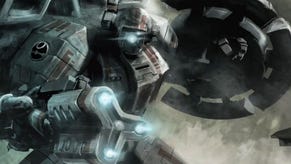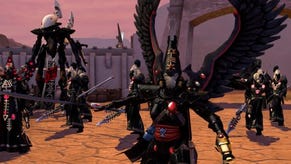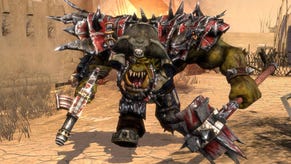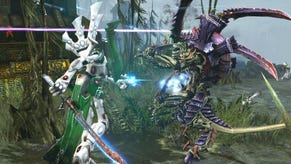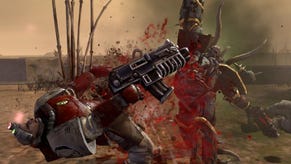Wot I Think: Dawn of War II Retribution
The second Warhammer 40,000: Dawn of War II expansion, Retribution, launched yesterday. Or today. Or tomorrow. Or never. Or whenever. All at once. Depends on where you are and where you download from, basically. This hasn't enjoyed the pan-continental release date it should have done, despite being so inherently online a title. With a bit of luck, you can purchase Relic's sci-fi RTS/RPG mash-up from the likes of Steam and Direct2Drive right now, and if you can't you should have access on the 4th, online and at retail. Should you, though? Well, that's where the following words come in. Consider me your Dreadnought of truthiness.

Ah, we're at that stage again. It happened with Dawn of War 1, now it's happening with the RPG-tinged sequel. Past a certain point, after a few expansion packs, a few more playable races and an armour-plated mountain of added features, there's just so much stuff in there that the game has little option but to seek total excess. Total, bloody, crazy, beautiful excess. For all the apparent laser-focusing of this second DOW2 standalone add-on's title and plot setup, in fact it's just a giant, enthusiastic explosion of future-war. Retribution? Superultrabution, more like.
No lone campaign focused only on the troubled Space Marine chapter the Blood Ravens here - instead, each of the now six playable factions gets its own turn at storytime. Admittedly, this does in practice involve having exactly the same missions and cutscenes for the most part, but Chaos, Orks, Tyranids, Eldar, Space Marines and the newly-added Imperial Guard are each blessed by plenty of talking heads and a tailored skill tree and loot selection of their own. There's just enough that I haven't particularly objected to playing through the same missions two or three times, but I suspect I'd have to be a special kind of 40K nutter to want to burn through all half-dozen iterations of it.
It struggles in terms of plot - being a pretty paper-thin 'hunt the bad guy' tale in the first place, then confused by awkwardly trying to pin six different motivations to that. When you are bad guys hunting an even badder guy it ends up pretty oblique (and alas not in a terribly nuanced way). But then that's always been 40K's thing: everyone's a massive wanker in one way or another. While it might feel a little cursory to those hanging on the fate of the Chaos-tinged Blood Ravens and their quest to be loved again or whatever, in practice it just doesn't matter.
Why? Because you've got the best toybox in the known universe. Where in the last expansion, Chaos Rising, your happyfuntimes were hung around the impossibly meaty shoulders of four Space Marine hero archetypes, here each of the six races has four archetypes. Each of these has their own, bespoke tech tree, packed with weird buffs and increasingly ludicrous special abilities. Chaos' Eliphias, for instance, was by the end of that campaign eating about a dozen souls whole in one greedy gulp. Meanwhile, his fat, rotting Plague Marine mate was busily spawning a temporary zombie from the corpse of anything that died in his presence. Then the Chaos Sorcerer was creating clones of the most powerful enemy units on the battlefield. The fourth guy, I barely even remember what he had by the end - throwing all the grenades in the world and demolishing buildings with some ludicrously large gun that required no setup time, or something.
The point is, it's no drip-feed of incremental rewards. It's bigger, BIGGER,
BIGGER
At a breakneck pace, too. Never too easy and never too stupid, it accomplishes the remarkable feat of retaining the need for tactics and micro-management whilst also being off-the-hook crazy. Take, for instance, the Imperial Guards. One of the core abilities is to execute a soldier in a chosen unit, which in turn makes the rest of that unit crap its khaki undies and fight like there's no tomorrow. Towards the end of the campaign, that effect makes any Impy Goo within visible rage go battle-crazy, the squad who lost a man turn invulnerable, any nearby enemies become so unnerved by the open insanity displayed that they forget how to shoot properly, and the guy responsible, Lord Berrn, become able to execute at a rate of knots. Meanwhile, Lord General Castor is cracking out supply drops that instantly replenish any diminished units. It's absolutely ludicrous.
It's also the Imperial Guard incarnate: the game simultaneously understands and focuses these hapless soldiers' purpose and nature. The genetically-enhanced Space Marines are the fist of the human Imperium - but these everyday soldiers are just the fingernails. They are cannon fodder incarnate, recruited almost more to die than to kill, and are thus endlessly reinforced. While in terms of weaponry and abilities they might seem a little vanilla alongside the heightened sci-fi absurdity of the other five factions, it's their very disposability that makes them so enticingly weird. When I play DOW2, I don't like to lose soldiers - it feels like a waste, it feels like I'm not playing that well, and frankly it burns resources. In the Impy Goo's case, wanton sacrifice is positively a virtue. What could have been boring soldier-men become psychopathic fanatics, with the scale of their death toll matched only by the sadistic fervour of their commanders. Remember, in the first Call of Duty, the start of the Russian campaign? You're given three bullets but no gun, told to seize a weapon from the first fallen comrade you see and threatened with execution if you ever move any direction than forwards. The Imperial Guard is basically that played for chilling laughs.
Lead 'hero' Castor is a delight in this regard, a sort of Victorian hunter-general convinced everyone's slacking and openly relishing the chance to punish them for it, while at the same time positively thrilling in the chance to coolly murder alien hordes. There's plenty of earnest chest-thumping in the Space Marine and Eldar campaigns, or slightly tiresome sibilant boo-hissing in Chaos, but it's the double-whammy of fanaticism and humour in the Impy Goo's that bears the game's best writing. I've yet to try Ork and Tyranid campaigns, but I'm presuming broader humour from the former and alien minimalism from the latter. I love that they're still they're to go back to, after I've put in some 15 hours of singleplayer already, but I don't exactly relish ploughing through the opening tutorial missions and more heavily-scripted fights again. Knowing I'm doubtless in for some more full-on crazy special abilities and stacking powers means it remains a lure nonetheless.
What also shines is that the game actively gives you a choice between playing it as a strategy game or a massively overclocked Diablo. For every mission, you can either take your four heroes along and concentrate resources on buffing them to maxibuff, or your can replace them with Honor Guard that cleave closer to the units found in multiplayer, plus increase the population capacity so you can field more general units. Also, mission rewards offer a choice between unlocking new units or unit upgrades, or simply indulging yourself in a colossal piece of loot for one of the heroes. It is entirely possible to play the campaign with just your four uber-characters and pretty much ignore building anything. I would argue that's a less satisfying way of playing it than the middleground of a couple of heroes and a small retinue, but what's important is it's no longer stuck in an awkward halfway house between RTS and RPG. It lets you pick which one you want to play, which makes the old formula make so much more sense. It also livens up the repeat plays an awful lot; the missions might be the same, by my tactics and abilities can be quite profoundly different.
At the same time, I do miss caring at a level beyond OTT war and mega-biff. While last expandalone Chaos Rising hardly deserves an entry on the videogame narrative scroll of fame, it did a pretty stand-up job of juggling loot hunger, huge fights and having a vested interest in the broad but solid archetypes that made up its core cast. They were on the road to hell, I got the chance to viciously toy with their morality, and I had a vested interest in finding out who the 24-style traitor in their ranks was. Here, I just want, crave more stuff, more powers, more crazy. It's an almost exact trade-off rather than a reduction in appeal, but what a remarkable feat it would have been to achieve both. Given that would require making no less than 24 characters semi-rounded and interesting, I'm hardly blaming Relic for not pulling it off, however.
Multiplayer I am, as I have always been, less excited about. It is solid, it is glossy and it is loud, plus the Imperial Guard mesh in remarkably well - they're surprisingly various and meaty compared to their DOW1 implementation, so definitely don't go thinking that they're a lesser option than the other races. Between their mighty tankitude and the lumbering meat-shield Ogryns, they have at least as much clout as any other faction. If anything, they're wilder than some of the more openly sci-fi factions such as Chaos and Eldar. I don't play often, but I'm enormously likely to gravitate to them when I do. While there are a raft of tweaks and boosts the multiplayer game at large, primarily a victory point tussle, remains fundamentally the same however; a remix of Company of Heroes with a little more micro and a lot more colour. It's a strong multiplayer offering for sure, but it doesn't feel like Only War, the 40K mantra. It feels like Only Videogame, and that's a shame. Clearly the spectre of StarCraft II looms large and trying to stand against it is perhaps an impossible feat, but I can't help but feel this is the game that could, if it wanted, co-exist securely by more aggressively pursuing difference . That it does have, to some extent, in the co-op arena mode that is Last Stand, introduced yonks ago but updated with new heroes and loot here. It's a more throwaway option, but it is the missing link between singleplayer's reward-based progression and multiplayer's commanding and conquering. I wish it, not trad. multiplayer, was the online focus and thus given more room to breath.
I'm left in a slightly odd place about Retribution. I have absolutely no doubt that it will remain installed on my PC for at least a year and be something I reliably dip in and out of, but to some extent that's achieved by sheer scale. Six races isn't all that much compared to DOW1 come its fourth expansion, but it makes for a huge game nonetheless. It's a hell of package, and a fine, fine way to delve into DOW2 if you've never done so before. I'd recommend Chaos Rising over it, however - it has a certain focus, and a certain splendour, which is a little lost in the marvellous scale of Retribution.
Don't got thinking this an either/or situation, mind. You should absolutely play both. This has been the remarkable thing about DOW2 after its brave but slightly wobbly start - it positively embraces change. Each of the three times it's welcomed us into its world of war craft, it has changed and grown in a way that, tradition tells us, expansions don't bother to. The maxi-splosion that is Retribution might not have the clarity of Chaos Rising, but it absolutely redeems any lingering sense that Dawn of War 2 is a smaller RTS. This is as big and noisy as it gets.






